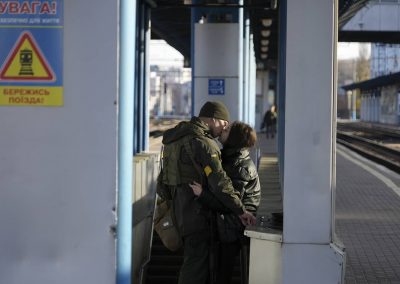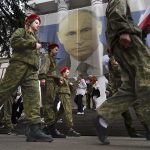
The orders came from on high, from Ukraine’s president and one of his ministers: Get trains running again to the latest city newly retaken by our troops.
“So literally: tanks, then trains,” said Ukrainian rail network boss Oleksandr Kamyshin, recalling the presidential instructions he received as the southern city of Kherson was being liberated in early November, ending eight months of Russian occupation.
Among bitter lessons that Ukrainians have had to learn in the nearly nine months since Russia invaded is that what is here today can be destroyed tomorrow and that nothing in war can be taken for granted.
Except, perhaps, the Ukrzaliznytsia.
The national rail company proudly boasts that 85% of trains ran on schedule last month. Night trains that rattle across the country still welcome customers with hot tea and clean sheets in the sleeping compartments. As well as people, trains carry cargo, aid and gear Ukraine needs to fight. They also are the easiest way for world leaders to meet with President Volodymyr Zelenskyy in Kyiv, the capital that in war is unreachable by air.
All this despite thousands of missile, bomb and artillery strikes that have crumpled bridges, blown up tracks and, says Kamyshin, killed nearly 300 rail workers and wounded almost 600 others since Russia invaded Ukraine on February 24.
“We are a machine,” Kamyshin said. “We keep running.”
Kamyshin spoke to The Associated Press in an exclusive interview at Kyiv’s majestic train station, as air raid sirens howled as they so often do over the capital. He paid them no mind. He was just back from Kherson and, in a few hours, was due to head back there again. Sipping from a flask of tea, he showed no fatigue. An imposing, fit-looking bear of a man, his black T-shirt and fatigues were neatly pressed.
“I am about efficiency,” said the 38-year-old CEO. He worked in private enterprise before taking the reins in 2021 of the state-owned rail company, Ukraine’s largest employer, with 231,000 workers and 16,700 miles of track.
One of his rules, he said, is: “War is not an excuse.”
Another rule is that he will not send rail workers up against dangers that he is not prepared to face himself. His dash to Kherson as the first Ukrainian troops were entering the southern city involved considerable risks, with portions driving along dirt tracks that de-miners had not yet cleared, he said.
He posted videos and photos of the odyssey on Twitter, showing wrecked and derailed rolling stock, torn up tracks and an impromptu breakfast of eggs fried outdoors with a camping stove. “Boots on the ground is our way,” he wrote.
“When my people see me and my team in Kherson, they know they’re fine to go there themselves,” he said. “It would be strange for me to send them there without being ready to go with them.”
In Kherson, he discovered that residents had already raised the Ukrainian flag on the train station roof. He photographed rail cars that Russian forces vandalized before they retreated, by painting over the rail company’s logo and Ukraine’s coat of arms — a trident — on their sides.
Most of all, he saw pressing needs: the city had no power or water and supplies were short. Clearing and repairing tracks so trains can bring in aid and people, and cargo can travel in and out freely again, was an urgent priority. In other retaken towns, the network has provided buses to carry passengers the last steps of the way when tracks are too damaged to be quickly repaired.
“The whole country should rely on the railways,” Kamyshin said. Passengers will “always be transported and (at) the station they will always get hot tea, medical first aid and all the rest.”
The network is targeted so frequently, with infrastructure damaged daily and thousands of times, that the rail company has largely given up talking publicly about attacks, Kamyshin said.
“We don’t want to be the most boring guy in the party, constantly reporting that we’ve been shelled,” he said. “We just go and fix it.”
Winter’s approach and the extra demands that the cold and dark will place on Ukraine’s war-battered power grid — Russia has repeatedly struck energy plants and facilities — are another challenge for the network that runs both diesel and electric locomotives. But Kamyshin said they were preparing for that too. He recently posted images of a belching steam locomotive that he said was being looked at as a possible alternative should all else fail.
“We always have Plan B,” he said. “Stations are always supplied with electricity, always light on, always warm, and it will be so even in the winter. That’s my job. That’s our goal. That’s what we fight for.”























